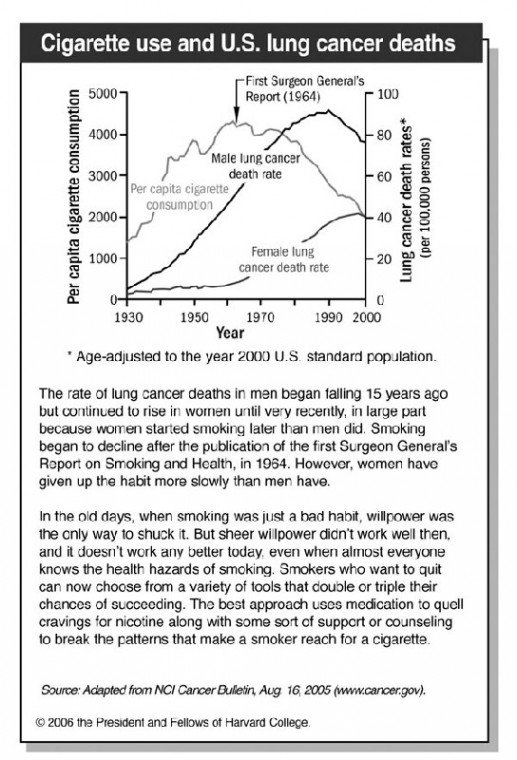Q: I was shocked to learn that Dana Reeve, the late Christopher
Reeve’s wife, died of lung cancer even though she was in her 40s
and not a smoker. I’ve heard that women are more prone to lung
cancer than men, even if they don’t smoke. Is that true?
By the Faculty of Harvard Medical School
Q: I was shocked to learn that Dana Reeve, the late Christopher Reeve’s wife, died of lung cancer even though she was in her 40s and not a smoker. I’ve heard that women are more prone to lung cancer than men, even if they don’t smoke. Is that true?
A: It’s true: Several studies suggest that women smokers develop lung cancer earlier and with less smoke exposure than men do. Compared with men who smoke, women smokers are also more likely to develop small-cell lung cancer. This form of lung cancer tends to spreads quickly and has the poorest prognosis. Men tend to develop a different form, called squamous-cell carcinoma, which produces more symptoms, so it’s easier to detect.
It should go without saying that smoking is by far the biggest cause of lung cancer, accounting for 85 percentto 90 percent of cases. But up to 15 percent of cases are among people who never smoked, like Dana Reeve. Among nonsmokers who develop lung cancer, about two-thirds are women. Both women and nonsmokers are more prone to a stealthier form of the disease (called adenocarcinoma), which spreads early on to other parts of the body.
Women have never smoked in the same numbers as men, but they account for nearly half of new lung cancer cases. Lung cancer deaths have dropped steadily in men since 1990. But they’ve continued to rise in women, leveling off a bit only recently (see illustration), probably because women continued to smoke in the 1960s and 1970s, when men were starting to quit.
What worries many experts is that smoking increased in women even after its dangers became known. One reason is that women believe that smoking helps them control their weight. Women also have a harder time quitting. Some experts think the death rate in women may start climbing again once baby boomers are well into their 60s, when most diagnoses are made. Another concern is that tobacco use continues to rise among high school girls.
Other risk factors for lung cancer include having a family history of the disease or having a prior lung disease, such as tuberculosis or chronic obstructive pulmonary disease. Exposure to asbestos, secondhand smoke, radon (a naturally occurring gas) and certain other airborne substances can also increase the risk of lung cancer. What you eat may also be important. For example, people whose diets are high in fat and cholesterol but low in fruits, vegetable and grains are more likely to develop lung cancer than people with more healthy eating habits.
Unfortunately, chest X-rays don’t pick up tiny lung cancers. A special, high-tech type of X-ray, known as computed tomography (CT), is an improvement. While using CT as a screening test hasn’t been shown to reduce deaths from lung cancer, most screening studies haven’t included women, so the issue is far from settled. A large screening trial that compares spiral CT (which rotates around the patient to scan the chest) with standard chest X-rays in both women and men is now under way. Results aren’t expected until 2010.
If lung cancer is caught early and hasn’t spread far, the first step is surgery to remove the cancer along with some of the surrounding healthy tissue. But about half of the 170,000 new cases diagnosed each year are already incurable because the cancer has spread within the lung or to other organs. And many older patients have poor lung function or other conditions that make surgery too dangerous.
Until recently, the only treatments for lung cancer were surgery or, if surgery wasn’t possible, radiation. Chemotherapy is now given after surgery (and sometimes after radiation) because it can cut recurrence by about 10 percent. One new therapy is Avastin, which helps thwart the growth of blood vessels that nourish the cancer. Compared with chemotherapy alone, Avastin plus standard chemotherapy has been shown to prolong survival in lung cancer patients by more than two months.
The five-year survival rate for lung cancer patients as a group is only 15 percent. But it’s 50 percent in those who are treated before the cancer spreads outside the lungs. So prevention and early detection are very important. Do everything you can to keep your home, car and work environment smoke-free. Secondhand smoke also counts: It causes an estimated 50,000 deaths each year in the United States. Be alert to symptoms of the disease: a cough that won’t go away and worsens over time, persistent chest pain, coughing up blood, shortness of breath, recurring pneumonia or bronchitis, weight loss and fatigue. See a clinician if they persist.
Submit questions to the Harvard Medical School Adviser at www.health.harvard.edu/adviser. Unfortunately, personal responses are not possible.













